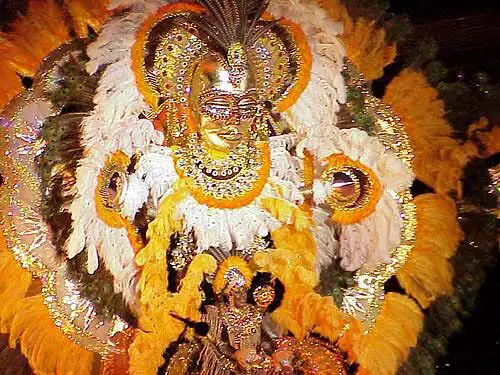Trinidad and Tobago Carnival – A Brief Overview

With only a few days before ‘High Mas’ it is time again to shine a spotlight on Trinidad & Tobago’s largest cultural festival, Carnival.
Where did the word “carnival” come from?
Hundred and hundreds of years ago, the followers of the Catholic religion in Italy started the tradition of holding a wild costume festival right before the first day of Lent. Because Catholics are not supposed to eat meat during Lent, they called their festival, carnevale – which means “to put away the meat.” As time passed, carnivals in Italy became quite famous; and in fact the practice spread to France, Spain, and all the Catholic countries in Europe. Then as the French, Spanish, and Portuguese began to take control of the Americas and other parts of the world, they brought with them their tradition of celebrating carnival.
Source: CarnivalPower.com (currently defunct)
In Trinidad the Carnival season begins almost immediately after the Christmas leftovers have been put in the fridge and ends with a final 3-day frenzy that ends on Ash Wednesday. Trinidad’s and Brazil’s Carnival are to me the most colorful and creative explosions of the human spirit. However there are many key differences between ours and theirs.

From Wikipedia.com:
In Trinidad, Carnival is a holiday season that lasts over a month and culminates in large celebrations in Port of Spain on the Sunday, Monday, and Tuesday before Ash Wednesday with Dimanche Gras, J’ouvert, and Mas (masquerade). Carnival is a festive time of costumes, dance, music, competitions, rum, and partying (also referred to as fete-ing). Music styles associated with Carnival include soca, calypso, and steel pan..
The annual Carnival steel pan competition known as the National Panorama competition is held in the weeks preceding Carnival with the finals held on the Saturday before the main event. Pan players compete in various categories such as “Conventional Steel band” or Single Pan” by performing renditions of the current year’s calypsos. Preliminary judging of this event for “Conventional Steel bands” has been recently moved to the individual pan yards where steel bands practice their selections for the competition.
.
.
“Dimanche Gras” takes place on the Sunday night before Ash Wednesday. Here the Calypso Monarch is chosen (after competition) and prize money and a vehicle bestowed. Also the King and Queen of the bands are crowned, where each band to parade costumes for the next two days submits a king and queen, from which an overall winner is chosen. These usually involve huge, complex, beautiful costumes.
.
.
J’ouvert, or “Dirty Mas”, takes place before dawn on the Monday (known as Carnival Monday) before Ash Wednesday. It means “goodbye to the flesh” or “welcome to daybreak” (depending on the interpretation). Here revelers dress in old clothes and cover themselves in mud, oil paint and body paint. A common character to be seen at this time is “Jab-jabs” (devils, blue, black or red) complete with pitch fork, pointed horns and tails. Here also, a king and queen of the J’ouvert are chosen, based on their representation of current political/social events/issues.
.
Carnival Monday involves the parade of the mas bands, but on a casual or relaxed scale. Usually revelers wear only parts of their costumes, and the purpose of the day is more one of fun than display or competition. Also on Carnival Monday, Monday Night Mas is popular in most towns and especially the capital, where smaller bands participate in competition..
Carnival Tuesday is when the main events of the carnival take place. On this day full costume is worn complete with make up and body paints/adornments. Each band has their costume presentation based on a particular theme, and contain various sections (some consisting of thousands of revelers) which reflect these themes. Here the street parade and eventual crowning of the best bands take place. After following a route where various judging points are located, the mas bands eventually converge on the Queen’s Park Savannah to pass “on the stage” to be judged once and for all.Also taking place on this day is the crowning of the Road March king or queen, where the singer of the most played song over the two days of the carnival is crowned winner, complete with prize money and usually a vehicle.
Ministry of Road (MOR) – Machel Montano (Road March 2014)
.
This parading and revelry goes on into the night of the Tuesday. Ash Wednesday itself, whilst not an official holiday, is marked by most by visiting the beaches that abound both Trinidad and Tobago. The most populated being Maracas beach and Manzanilla beach, where huge beach parties take place every Ash Wednesday. These provide a cool down from the previous five days of hectic partying, parades and competitions, and are usually attended by the whole family.
.Maracas Beach
.
Over the next few days I will be going into more detail about many of the key characters and cultural signifiers mentioned above, as these are the things that make Trinidad Carnival like no other. From the sights, sounds and of course the tastes!

Street food on every corner – pholourie, aloo pies
I hope that for many of you it will be an interesting introduction to a key component of my culture, and for those of you overseas who have memories of partying down here, I hope that it will make you so homesick that you will curse out your boss and jump on ‘d’ next plane! 😀
[random_content group_id=”114″]


